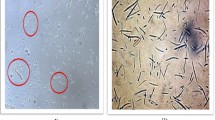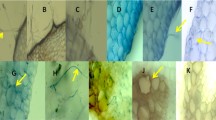Abstract
Bakanae is the major fungal disease of rice posing threat to rice production all over the world. In order to understand the physiological and biochemical basis of resistance, the disease free and Fusarium fujikuroi infected seedlings of two aromatic (PUSA 1121 and PUSA 1509) and two non-aromatic (PR 121 and PR 126) rice cultivars were evaluated. The seeds of rice cultivars were inoculated with the virulent isolate of F. fujikuroi. Percent disease incidence, percent field emergence, seedling length and biochemical traits of 25 days old seedlings raised from healthy (disease free) and pathogen inoculated seeds in the nursery were compared. The experimental design was RBD and data was analysed using tukey’s HSD test. The infection led to a significant decline in the chlorophyll content in the infected seedlings of the aromatic cultivars, whereas non-significant variation between healthy and infected seedling of non-aromatic rice cultivars was observed. Seed inoculation with the fungus resulted in significant increase in length of the infected seedlings in aromatic rice cultivars as compared to non-aromatic indicating the resistance response to the production of Gibberellic acid in non-aromatic rice cultivars. The endogenous GA enhanced significantly postinfection in the aromatic PUSA 1121 and PUSA 1509 seedlings. Post pathogenesis, the infected seedlings of aromatic cultivars retained lower level of total phenols. The depletion of phenols post infection in infected seedlings of aromatic cultivars may be due sugar depletion. Our results show that the higher total antioxidant and enzymatic activity in aromatic rice cultivars post infection could be a useful biochemical marker for screening the tolerance potential of rice cultivars against bakanae disease.



Similar content being viewed by others
References
Abbas, H. K., Tanaka, T., Duke, S. O., Porter, J. K., Wray, E. M., Hodges, L., et al. (1994). Fumonisin-and AAL-toxin induced disruption of sphingolipid metabolism with accumulation of free sphingoid bases. Plant Physiology,106, 1085–1093.
Adam, S., Castilla, N, P., & Cruz, C. M. V. (2018). Retrieved September 7, 2018, from http://www.knowledgebank.irri.org.
Amatulli, M. T., Spadaro, D., Gullino, M. L., & Garibaldi, A. (2012). Conventional and real-time PCR for the identification of Fusarium fujikuroi and Fusarium proliferatum from diseased rice tissues and seeds. European Journal of Plant Pathology,134, 401–408.
Ammajamma, R., & Patil, P. V. (2008). Biochemical factors imparting rust (Phakospora pachyrhizi) resistance in soybean, Karnataka. Journal of Agricultural Science,21, 65–69.
Bashalah, M. O., Sulaiman, A. A. A., & Mohammad, S. (1984). Metabolic changes in the leaves of Solanum melongia affected with Alternaria tenuissima. Indian Phytopathology,37, 46–51.
Bashyal, B. M., Aggarwal, R., Banerjee, S., Gupta, S., & Sharma, S. (2014). Pathogenicity, ecology and genetic diversity of the Fusarium spp. associated with an emerging bakanae disease of rice (Oryza sativa L.) in India. In R. N. Kharwar (Ed.), Microbial diversity and biotechnology in food security (pp. 307–314). Berlin: Springer.
Dubois, M., Giles, K. A., Hamilton, J. K., Rebers, P. A., & Smith, F. (1956). Colorimetric method for the determination of sugars and related substances. Analytical Chemistry,28, 350–356.
Ghazanfar, M. U., Javed, N., Wakil, W., & Iqbal, M. (2013). Screening of some fine and coarse rice varieties against bakanae disease. Journal of Agricultural Research,51, 41–49.
Gilchrist, D. G. (1997). Mycotoxins reveal connections between plants and animals in apoptosis and ceramide signalling. Cell Death and Differentiation,4, 689–698.
Guoliang, L., Shucheng, L., Zhiwei, S., Lian, X., Guang, C., & Jinmao, Y. (2014). A simple and sensitive HPLC method based on pre-column fluorescence labelling for multiple classes of plant growth regulator determination in food samples. Food Chemistry,170, 123–130.
Hiscox, J. D., & Israelstam, G. F. (1979). A method for the extraction of chlorophyll from the leaf tissues without maceration using dimethyl sulphoxide. Canadian Journal of Botany,57, 1332–1334.
Hossain, K. S., Miah, M. A. T., & Bashar, M. A. (2011). Preferred rice varieties, seed source, disease incidence and loss assessment in bakanae disease. Journal of Agrometeorology for Environment,5, 125–128.
Hossain, K. S., Miah, M. A. T., & Bashar, M. A. (2013). New method for screening rice varieties against bakanae disease. Bangladesh Journal of Botany,42(2), 315–320.
Hwang, I. S., Kang, W. R., Hwang, S. C. B., Yun, S. H., & Ahn, I. P. (2013). Evaluation of Bakanae disease progression caused by Fusarium fujikuroi in Oryzasativa L. Journal of Microbiology,51, 858–865.
Kandakoor, S. B., Khan, H. K., Chakravarthy, A. K., Kumar, C. T. A., & Venkataravana, P. (2014). Biochemical constituents influencing thrips resistance in groundnut germplasm. Journal of Environment Biology,35, 675–681.
Kaur, G., & Mehrotra, R. S. (1990). Biochemical studies in pigeon pea varieties resistant and susceptible to Phytophothora blight. Plant Disease Research,5, 122–125.
Kirk, J. T. O., & Allen, R. L. (1965). Dependence of chloroplast pigment synthesis on protein synthesis: effects of actidione. Biochemical and Biophysical Research Communications,22, 523–530.
Kuzniak, E., & Sklodowska, M. (2005). Fungal pathogen-induced changes in the antioxidant systems of leaf peroxisomes from infected tomato plants. Planta,222, 192–200.
Lee, Y. P., Takahashi, T. (1966). An improved colorimetric determination of amino acids with the use of ninhydrin. Analytical Biochemistry, 14(1), 71–77.
Lee, D. H., Kim, Y. S., & Lee, C. B. (2001). The inductive responses of the antioxidant enzymes by salt stress in rice (Oryza sativa L.). Journal of Plant Physiology,158, 737–745.
Li, G., You, J., Song, C., Sun, Z., & Xia, L. (2011). A developed pre-column derivatization method for the determination of free fatty acids in edible oils by reversed phase HPLC with fluorescence detection and its application to Lycium barbarum seed oil. Food Chemistry,125(4), 1365–1372.
Lowry, O. H., Rosenbrough, N. J., Farr, A. L., & Randall, R. J. (1951). Protein measurement with the Folinphenol reagent. Journal of Biology and Chemistry,193, 265–275.
Marklund, S., & Marklund, G. (1974). Involvement of the superoxide anion radical in the autooxidation of Pyragallol and a convenient assay for superoxide dismutase. European Journal of Biochemistry,47, 469–474.
Matic, S., Gullino, L. M., & Spadaro, D. (2017). The puzzle of bakanae disease through interactions between Fusarium fujikuroi and rice. Frontiers in Bioscience,9, 333–344.
Murata, T., Akazawa, T., & Furuchi, S. (1968). Enzymic mechanism of starch breakdown in germinating rice seeds I. An analytical study. Plant Physiology,43, 1899–2005.
Murria, S., Kaur, N., Arora, N. K., & Mahal, A. K. (2018). Field reaction and metabolic alterations in grape (Vitis vinifera L.) varieties infested with anthracnose. Scientia Horticulturae,235, 286–293.
Panda, S. K. (2007). Chromium mediated oxidative stress and ultrastructural changes in root cells of developing rice seedlings. Journal of Plant Physiology,164, 1419–1428.
Pannu, P. P. S., Kaur, J., Singh, G., & Kaur, J. (2012). Survival of Fusarium moniliforme causing foot rot of rice and its virulence on different genotypes of rice and basmati rice. Indian Phytopathology,65, 149–209.
Patel, A., Patel, A., Patel, A., & Patel, N. M. (2010). Estimation of flavonoid, polyphenolic content and in vitro antioxidant capacity of leaves of Tephrosia purpurea Linn. (Leguminosae). International Journal of Pharmaceutical Science and Research,1(1), 66–77.
Puyam, A., Pannu, P. P. S., Kaur, J., & Shikha, S. (2017). Cultural, morphological and molecular variability of Sheld causing foot rot disease of basmati rice in Punjab. Journal of Mycology and Plant Pathology,47(4), 369–381.
Saleh, L., & Plieth, C. (2009). Fingerprinting antioxidative activities in plants. Plant Methods,5, 2.
Sang, W. G., Pyeong, K. J. H., Shin, H. S. C., Myung, C. S., Park, H. K., Lee, G. H., et al. (2015). Physio biochemical characterisation of bakanae disease tolerant rice. Journal of Korean Society for International Agriculture,27, 460–468.
Sathiyanathan, S., & Vidhyashekaran, P. (1981). Role of phenolics in brown spot disease resistance in rice. Indian Phytopathology,34(2), 225–227.
Senthil, V., Ramasamy, P., Elaiyaraja, C., & Ramola, E. A. (2010). Some photochemical properties affected by the infection of leaf spot disease of Cucumis sativus L. caused by Penicillum notatum. African Journal of Basic and Applied Science,2, 64–70.
Shannon, L. M., Kay, E., & Lew, J. Y. (1966). Peroxidase isozymes from horse radish roots: Isolation and physical properties. Journal of Biology and Chemistry,241, 2166–2172.
Sunani, S. K., Bashyal, B. M., Rawat, K., Manjunatha, C., Sharma, S., Prakash, G., et al. (2019). Development of PCR and loop mediated isothermal amplification assay for the detection of bakanae pathogen Fusarium fujikuroi. European Journal of Plant Pathology,154, 715.
Swain, T., & Hills, W. E. (1959). The phenolic constituents of Prunus domestica and the quantitative analysis of phenolic constituents. Journal of Science and Food Agriculture,10, 63–68.
Taheri, P. A., Irannejad, M., & Goldani, T. S. (2014). Oxidative burst and enzymatic antioxidant systems in rice plants during interaction with Alternaria alternata. European Journal of Plant Pathology,140, 829–839.
Torres, M. A., Jones, J. D. G., & Dang, J. L. (2006). Reactive oxygen species signalling in response to pathogens. Plant Physiology,141, 373–378.
Tudzynski, B., Mihlan, M., Rojas, M. C., Linnemannstons, P., Gaskin, P., & Hedden, P. (2003). Characterization of the final two genes of the gibberellin biosynthesis gene cluster of Gibberella fujikuroi–des and P450-3 encode GA4 desaturase and the 13-hydroxylase, respectively. Journal of Biology Chemistry,278, 28635–28643.
Vargas, W. A., Martin, J. M., Rech, G. E., Rivera, L. P., Benito, E. P., Diaz-Minguez, J. M., et al. (2012). Plant defense mechanisms are activated during biotrophic and necrotrophic development of Colletotrichum graminicola in maize. Plant Physiology,4, 457–467.
Velazhahan, R., Jayaraj, J., Salaheddin, K., Kumar, S. R., & Muthukrishnan, S. (2006). Xanthomonas oryzae pv. Oryzae infection triggers accumulation of phenolics, defense related enzymes and thaumatin-like proteins in rice leaves. Archives of phytopathology and plant protection,39(5), 329–339.
Vidhyasekaran, P. (2008). Induction and evasion of pathogenesis-related proteins. In: Fungal pathogenesis in plants and crops: Molecular biology and host defense mechanisms, (2nd ed., pp. 345–409). CRC Press: Boca Raton.
Wu, C., Miloslavskaya, I., Demontis, S., Maestro, R., & Galaktionov, K. (2004). Regulation of cellular response to oncogenic and oxidative stress by Seladin-1. Nature,432, 640–645.
Zainudin, N. A. I. M., Razak, A. A., & Salleh, B. (2008). Bakanae disease of rice in Malaysia and Indonesia: Etiology of the causal agent based on morphological, physiological and pathogenicity characteristics. Journal of Plant Protection and Research,48, 475–485.
Zhou, B., Chen, Z. D. U. L., Ye, X., & Li, N. (2012). Correlation between resistance of eggplant and defense-related enzymes and biochemical substances of leaves. African Journal of Biotechnology,11(74), 13896–13902.
Author information
Authors and Affiliations
Corresponding author
Ethics declarations
Conflict of interest
The authors declare that they have no conflict of interest.
Additional information
Publisher's Note
Springer Nature remains neutral with regard to jurisdictional claims in published maps and institutional affiliations.
Rights and permissions
About this article
Cite this article
Chhabra, R., Kaur, N. & Bala, A. Physiological and biochemical alterations imposed by Fusarium fujikuroi infection in aromatic and non-aromatic rice cultivars. Plant Physiol. Rep. 24, 563–575 (2019). https://doi.org/10.1007/s40502-019-00486-4
Received:
Accepted:
Published:
Issue Date:
DOI: https://doi.org/10.1007/s40502-019-00486-4




